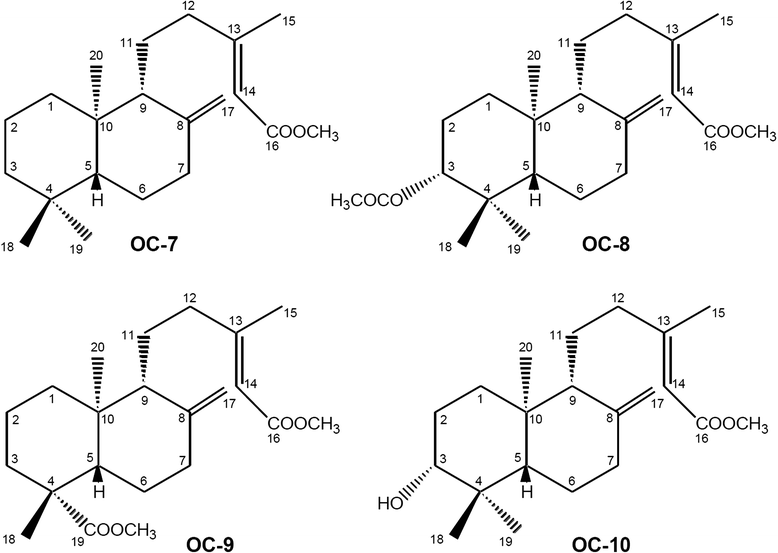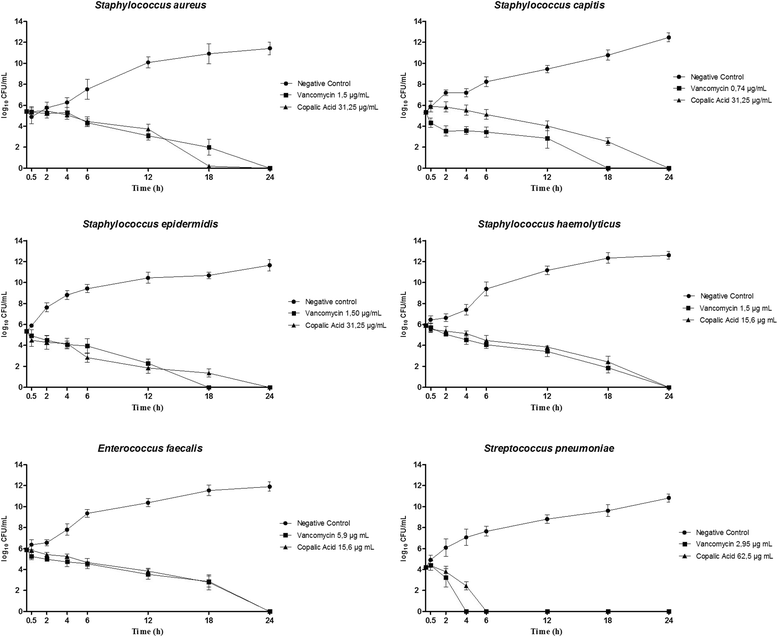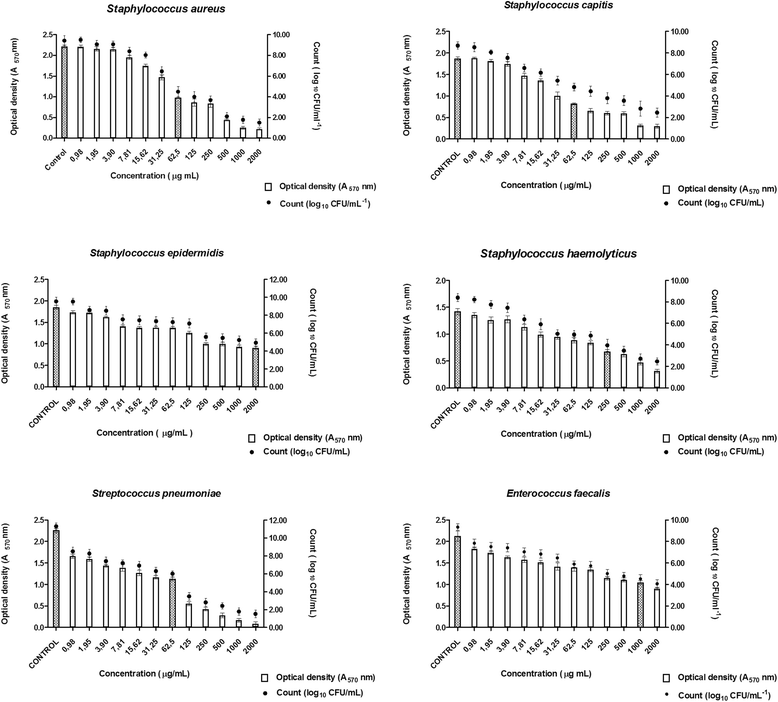Copaifera langsdorffii oleoresin and its isolated compounds: antibacterial effect and antiproliferative activity in cancer cell lines
- PMID: 26691920
- PMCID: PMC4687089
- DOI: 10.1186/s12906-015-0961-4
Copaifera langsdorffii oleoresin and its isolated compounds: antibacterial effect and antiproliferative activity in cancer cell lines
Abstract
Background: Natural products display numerous therapeutic properties (e.g., antibacterial activity), providing the population with countless benefits. Therefore, the search for novel biologically active, naturally occurring compounds is extremely important. The present paper describes the antibacterial action of the Copaifera langsdorffii oleoresin and ten compounds isolated from this oleoresin against multiresistant bacteria; it also reports the antiproliferative activity of the Copaifera langsdorffii oleoresin and (-)-copalic acid.
Methods: MICs and MBCs were used to determine the antibacterial activity. Time-kill curve assays provided the time that was necessary for the bacteria to die. The Minimum Inhbitory Concentration of Biofilm (CIMB50) of the compounds that displayed the best results was calculated. Cytotoxicity was measured by using the XTT assay.
Results: The diterpene (-)-copalic acid was the most active antibacterial and afforded promising Minimum Inhibitory Concentration (MIC) values for most of the tested strains. Determination of the bactericidal kinetics against some bacteria revealed that the bactericidal effect emerged within six hours of incubation for Streptococcus pneumoniae. Concerning the antibiofilm action of this diterpene, its MICB50 was twofold larger than its CBM against S. capitis and S. pneumoniae. The XTT assay helped to evaluate the cytotoxic effect; results are expressed as IC50. The most pronounced antiproliferative effect arose in tumor cell lines treated with (-)-copalic acid; the lowest IC50 value was found for the human glioblastoma cell line.
Conclusions: The diterpene (-)-copalic acid is a potential lead for the development of new selective antimicrobial agents to treat infections caused by Gram-positive multiresistant microorganisms, in both the sessile and planktonic mode. This diterpene is also a good candidate to develop anticancer drugs.
Figures




Similar articles
-
Copaifera of the Neotropics: A Review of the Phytochemistry and Pharmacology.Int J Mol Sci. 2018 May 18;19(5):1511. doi: 10.3390/ijms19051511. Int J Mol Sci. 2018. PMID: 29783680 Free PMC article. Review.
-
Copaifera reticulata oleoresin: Chemical characterization and antibacterial properties against oral pathogens.Anaerobe. 2016 Aug;40:18-27. doi: 10.1016/j.anaerobe.2016.04.017. Epub 2016 Apr 23. Anaerobe. 2016. PMID: 27118478
-
Antibacterial activity of Pinus elliottii against anaerobic bacteria present in primary endodontic infections.Anaerobe. 2014 Dec;30:146-52. doi: 10.1016/j.anaerobe.2014.09.013. Epub 2014 Sep 28. Anaerobe. 2014. PMID: 25270831
-
Assessment of the antibacterial, antivirulence, and action mechanism of Copaifera pubiflora oleoresin and isolated compounds against oral bacteria.Biomed Pharmacother. 2020 Sep;129:110467. doi: 10.1016/j.biopha.2020.110467. Epub 2020 Jun 27. Biomed Pharmacother. 2020. PMID: 32603890
-
Occurrence, chemical composition, biological activities and analytical methods on Copaifera genus-A review.Biomed Pharmacother. 2019 Jan;109:1-20. doi: 10.1016/j.biopha.2018.10.030. Epub 2018 Nov 3. Biomed Pharmacother. 2019. PMID: 30396065 Review.
Cited by
-
Copaifera of the Neotropics: A Review of the Phytochemistry and Pharmacology.Int J Mol Sci. 2018 May 18;19(5):1511. doi: 10.3390/ijms19051511. Int J Mol Sci. 2018. PMID: 29783680 Free PMC article. Review.
-
Evaluation of the biological activities of Copaiba (Copaifera spp): a comprehensive review based on scientometric analysis.Front Pharmacol. 2023 Sep 1;14:1215437. doi: 10.3389/fphar.2023.1215437. eCollection 2023. Front Pharmacol. 2023. PMID: 37719866 Free PMC article.
-
Toxicological Effects of Copaiba Oil (Copaifera spp.) and Its Active Components.Plants (Basel). 2023 Feb 27;12(5):1054. doi: 10.3390/plants12051054. Plants (Basel). 2023. PMID: 36903915 Free PMC article. Review.
-
Assessment of thyme honey oral gel for the prevention of adriamycin and cyclophosphamide chemotherapy-induced oral mucositis in patients with breast cancer.Support Care Cancer. 2023 Jul 28;31(8):497. doi: 10.1007/s00520-023-07943-9. Support Care Cancer. 2023. PMID: 37505326
-
Investigation of Safety Profile of Four Copaifera Species and of Kaurenoic Acid by Salmonella/Microsome Test.Evid Based Complement Alternat Med. 2019 Jan 10;2019:7631531. doi: 10.1155/2019/7631531. eCollection 2019. Evid Based Complement Alternat Med. 2019. PMID: 30733813 Free PMC article.
References
-
- Simões M, Simões LC, Vieira MJ. A review of current and emergent biofilm control strategies. Food Sci Technol. 2010;43(4):573–83.
Publication types
MeSH terms
Substances
LinkOut - more resources
Full Text Sources
Other Literature Sources
Medical
Molecular Biology Databases

